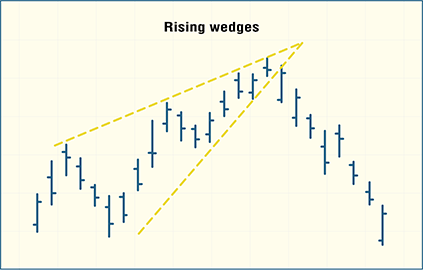Novice Traders’ Notebook
Other Reversal Patterns
3. Wedge Formation

Wedges are similar to triangles, but differ in that with triangles, there is always one boundary line that remains flat; wedges are characterized by both boundary lines being at a slant. Wedges should not be mistaken for pennants, which are much shorter in duration.
A. Rising wedges
Rising wedges can be identified by both boundary lines heading up, with the lower line ascending at a sharper pitch than the upper one, indicating fluctuating and strengthening price activity, with the lines eventually meeting. A rising wedge is usually at least three weeks in forming and lasts approximately three months, perhaps four months in all.
B. Falling wedges
Falling wedges can be identified by both boundary lines heading down, with the lower line descending at a sharper angle than the upper one, with the lines eventually meeting. This wedge is part of a consolidation pattern.
— EMS Flynn
REFERENCES
Bowman, Melanie, and Thom Hartle [1990]. “Reversal Patterns,” Technical Analysis of STOCKS & COMMODITIES, Volume 8: October.
Bulkowski, Thomas [2000]. Encyclopedia Of Chart Patterns, John Wiley & Sons.
_____ [1997]. “On Rising Wedges,” Technical Analysis of STOCKS & COMMODITIES, Volume 15: May.
_____ [2002]. Trading Classic Chart Patterns, John Wiley & Sons.
Meyers, Thomas A. [1989]. The Technical Analysis Course, Probus Publishing Co.